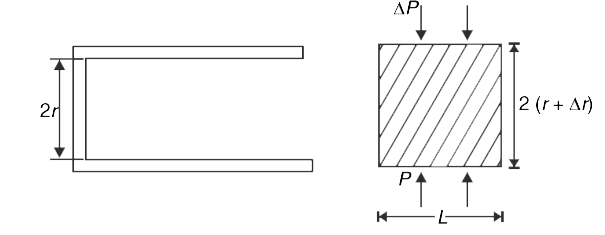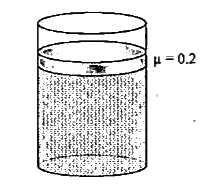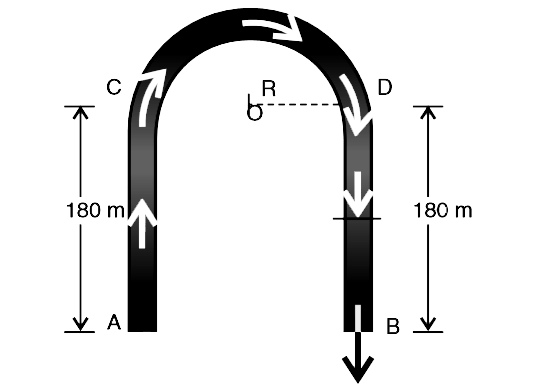A bottle has an opening of radius a and length b. A cork of length b and radius (a+ΔA) is compressed to fit into the opening completely (See figure). If the bulk modulus of cork is B and frictional coefficient between the bottle and cork is ? then the force needed to push the cork into the bottle is :

(πμBb)Δa
(4πμBb)Δa
(2πμBb)Δa
(πμBb)a
Step by step video & image solution for A bottle has an opening of radius a and length b. A cork of length b and radius (a+Delta A) is compressed to fit into the opening completely (See figure). If the bulk modulus of cork is B and frictional coefficient between the bottle and cork is ? then the force needed to push the cork into the bottle is : by Physics experts to help you in doubts & scoring excellent marks in Class 12 exams.
Updated on:21/07/2023Topper's Solved these Questions
Similar Questions
A rigid cylindrical container has inner radius r. A cork having radius r+Δr and length L is to be fitted so as to close the container. Uniform pressure (ΔP) is needed on the curved cylindrical surface of the cork. Poisson’s ratio of a cork is almost zero, and its bulk modulus is B.

(a) Calculate ΔP
(b) After the cork is fitted how much force will be needed to pull it out of the container? Coefficient of friction between the container and the cork is μ.
View SolutionFigure-2.47 shows a cylindrical container of radius 5cm and a piston is fitted in it to enclose a length of 20 cm in it.The cylinder contains an ideal gas at a pressure of 1 atmosphere and 300 K temperature.The cylinder is slowly heated and it is found that the piston starts displacing when the gas temperature reaches 600 K. It is given that the friction coefficient between the piston sidesand the container wall is 0.2. Find the normal force acting between piston sides and the container wall per unit length ofits circumference.

View Solution
Knowledge Check
The neck and bottom of a bottle are 3 cm and 15 cm in radius respectively. If the cork is pressed with a force 12 N in the neck of the bottle, then force exerted on the bottom of the bottle is :-
A30 NB150 NC300 ND600 NA man of mass m walks from end A to the other end B of a boat of mass M and length l. The coefficient of friction between the man and the boat is μ an neglect any resistive force between the boat and the water.
AIf the man runs at his maximum acceleration, the acceleration of the boat is (m/M)μg.BThe minimum time take by the man to reach the other end of the boat is √2MI(M+m)μgCIf man runs at his maximum acceleration the acceleration of boat is mm+MμgDThe minimum time take by the man to reach the other end of the boat is √2ml(M+m)μgA Yo-Yo of mass m has an axle of radius b and a spool of radius R. The Yo-Yo is placed upright on a table and string is pulled with a horizontal force →F to the right as shown in figure.

The static friction coefficient between Yo-Yo and table is μs. Now there are two cases.
case (a): The string is pulled very gently?
case (b): The string is jerked hard?AClockwise in case (a)BAnticlockwise in case (a)CClockwise in case (b)DAnticlockwise in case (b)
A flat race track consists of two straight section AC and DB each of length 180 m and one semi circular section DC of radius R = 150 m. A car starting from rest at A has to reach B in least possible time (the car may cross through point B and need not stop there). The coefficient of friction between the tyres and the road is μ=0.6 and the top speed that the car can acquire is 180 kph. Find the minimum time needed to move from A to B under ideal conditions. Braking is not allowed in the entire journey [g=10m/s2]

View SolutionA ball moves along a curved path of radius 5m as shown in figure. It starts from point A and reaches the point B. Calculate the normal force that acts on the ball at B, assuming that there is no friction between the ball and the surface of contact.
View SolutionA block of mass 5 kg is (i) pushed in case (A) and (ii) pulled in case (B), by a force F = 20 N, making an angle of 30∘ with the horizontal, as shown in the figures. The coefficient of friction between the block and floor is μ=0.2 . The difference between the accelerations of the block, in case (B) and case (A) will be: (g=10ms−2)

View SolutionThe system is pushed by a force F as shown in figure All surface are smooth except between B and C friction coefficient between B and C is Minimum value of F to prevent block B from down ward slipping is

View SolutionThe system is pushed by a force F as shown in figure. All surfaces are smooth except between B and C Friction coefficient between B and C is μ. Minimum value of F to prevent blokc B from downward slipping is

View Solution
